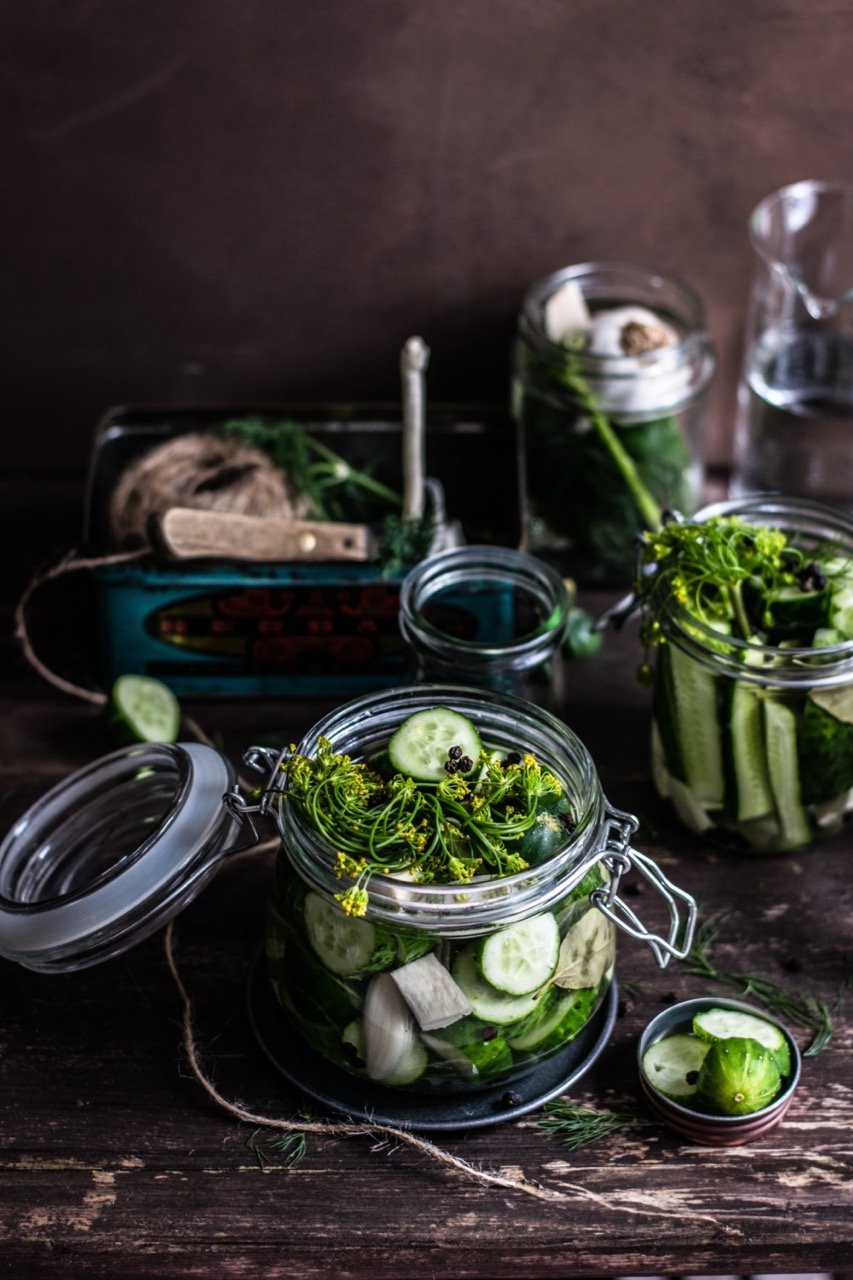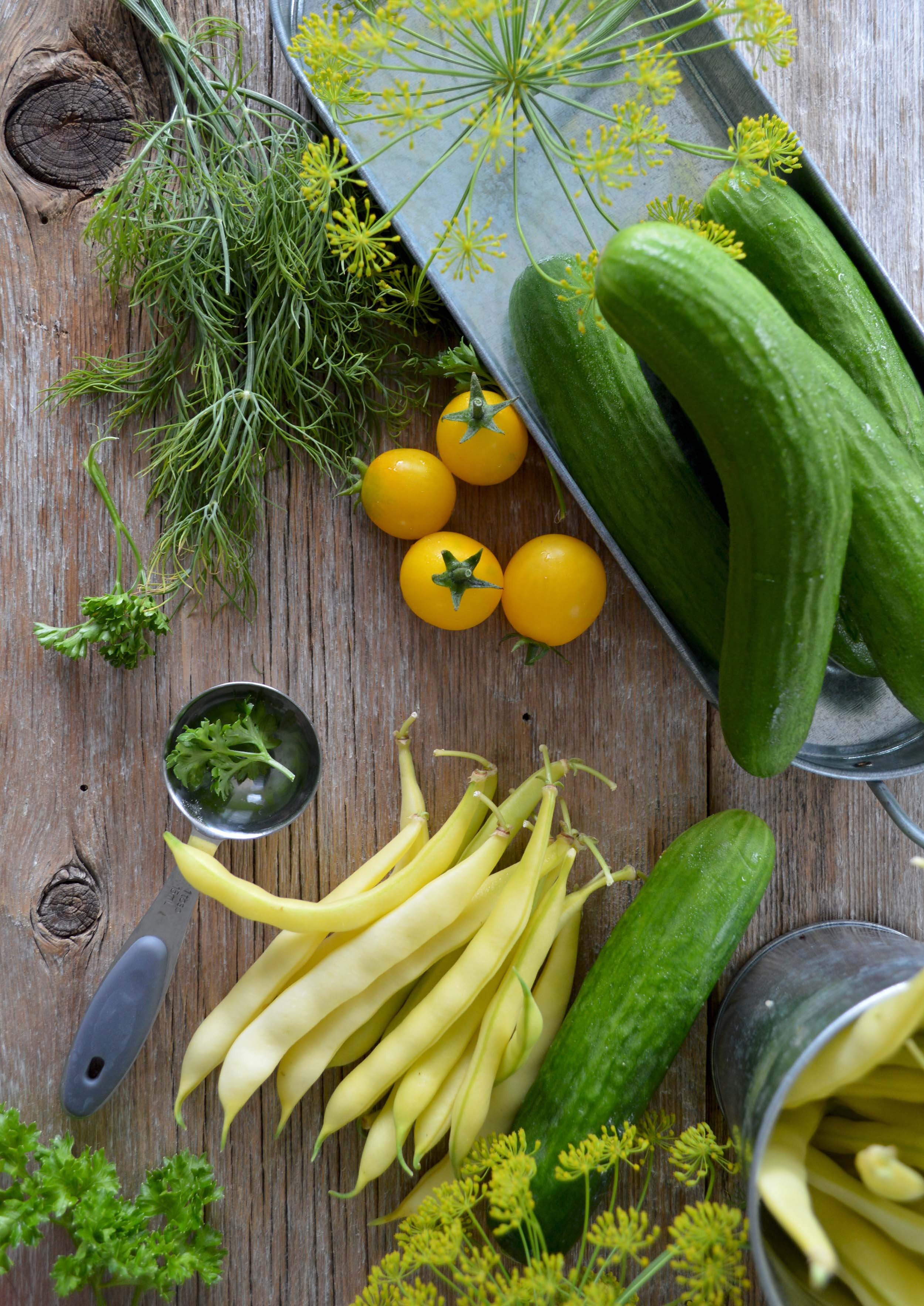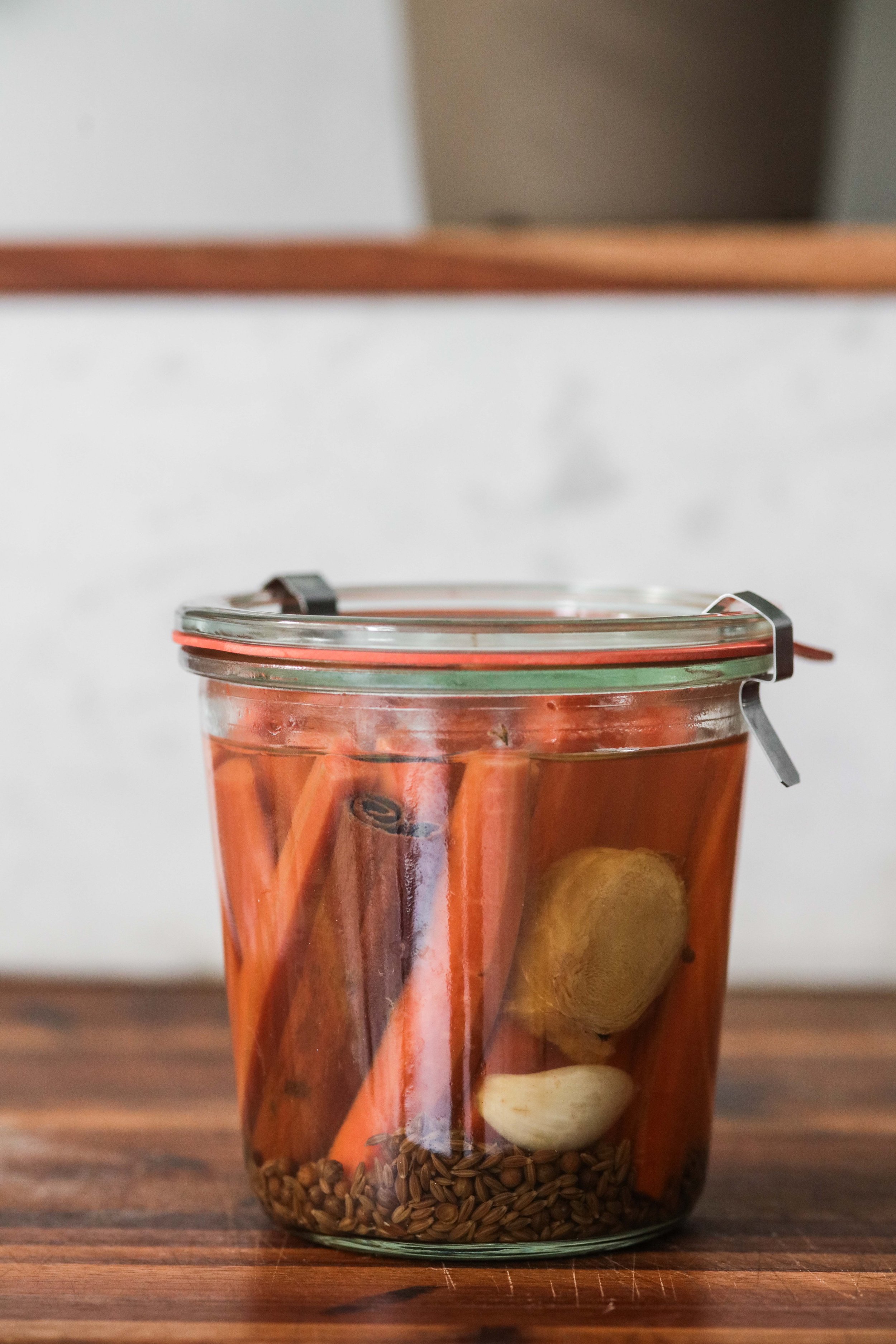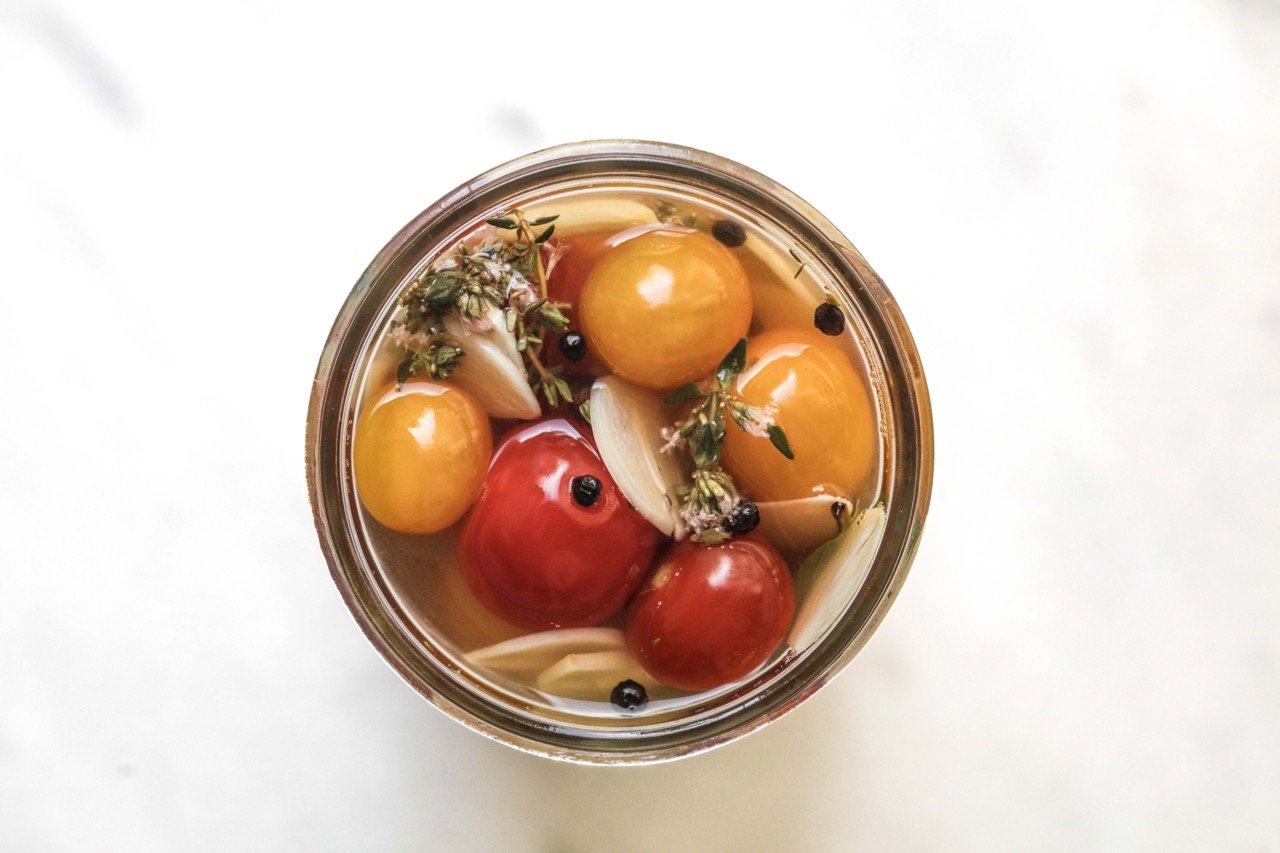Let’s Get Pickling

A local food artisan talks about the difference between vinegar and lacto-fermented pickles, and shares tips for pickling at home.
Technique + Recipes by Gary Leybman, The Pickled Pig
Photo by Monika Grabkowska
File pickling under “what’s old is new again.” This food preservation technique is a few thousand years old and practiced in culinary traditions around the world. And it’s been rediscovered, tinkered with, and updated for today with modern flavor combinations and farm-grown ingredients.
For food entrepreneur Gary Leybman, pickling is a way to connect with his Belarusian heritage. When his mother or grandmother prepared meals, there was always something pickled on the table, he says. A trained chef, Leybman started selling kimchi and other fermented products at farmers’ markets in 2014, sourcing ingredients from the farmers who sold alongside him. Today, an ample prep kitchen and fermentation room at The Pickled Pig in Walnut Hills, owned by Leybman and his wife, Libby, turns out ferments of all kinds for retail and wholesale customers.
How to
Gather your equipment and containers. Avoid plastic and reactive metals—use ceramic crocks, food-grade plastics, or glass. Sterilize everything before use with boiling water and then let cool.
Use high-quality, super-fresh produce and wash it well. Likewise, use fresh herbs and whole spices.
Use a good-quality sea salt without any anti-caking agents. Fine salt dissolves best.
For vinegar pickling, you’ll need lidded glass Mason jars. Make a basic brine of equal parts water and vinegar of your choice; add salt and sugar to taste. Heat the brine in a saucepan over high heat until the salt and sugar dissolve, then pour it over your vegetables and flavorings in the jars. Leave 1/2 inch of head space. Let the jars cool. Eat the pickles after about 30 minutes, or let sit at room temperature up to 48 hours for flavors to develop fully. Always refrigerate vinegar pickles and consume in a couple of weeks.
For fermenting, use a Eurpoean-style crock with a water lock, or Mason jars with airlock fittings. (The recipe on the following page calls for a lightly sealed Mason jar to let CO2 escape.) When you use glass containers, you can see fermentation happen. Layer your veggies in a way that’s attractive and then watch as they intermingle. Pack the vegetables and flavorings into the crock or jar. Leybman recommends a 3% salt brine made from 1 quart water and 2 tablespoons of fine salt. Pour the brine over the vegetables so that everything is submerged. Cover with the lid and airlock. Fermentation starts to work within 3 days; the brine will get cloudy and bubbly and the airlock will sputter. Crack open the crock and use your eyes and nose first (you want a slightly sour and spicy aroma). A pH meter should read 4.6 or lower (more acidic), or use pH testing papers. Refrigerate for a few days to set the flavors and slow down residual fermentation. Use within 1 year; store in the refrigerator.
Vinegar vs. Lactobacillus
Pickling preserves foods in an acidic environment that kills harmful bacteria. That can happen in two ways: via the addition of an acid, like vinegar, or by fermentation, which produces lactic acid. All kinds of produce, from cukes and cherry tomatoes to apples and strawberries, can be pickled in vinegar with herbs and spices. Yogurt, sourdough bread, kombucha, kimchi, and sauerkraut are among the many foods created by fermentation.
Lacto-fermentation relies on fresh, clean ingredients, a 3% salt brine, and the introduction of Lactobacillus, which, over time, breaks down the natural sugar in the produce into lactic acid plus carbon dioxide. (By comparison, fermented beverages like beer and wine rely on a yeast called Saccharomyces to convert sugar to alcohol and CO2.)
Since fermentation deals in bacteria, some care is required to invite the good bugs to do their work and prevent the bad guys from spoiling the food or, worse, making you sick. Beneficial bacteria thrive in a zero-oxygen environment, while the bad ones need oxygen to survive. So you need a container (glass or crockery) with an airlock that allows the CO2 to escape while preventing air from getting in.
You can make a batch of vinegar pickles in just 30 minutes—for example, quick-pickled red onion for tacos or baby cucumbers for burger night. Or you can try a more involved process like the recipe here from The Pickled Pig, which calls for soaking the cucumbers in a solution that preserves their crispness. “With vinegar pickles, the flavor depends on the vinegar you use,” Leybman says. “If you don’t want to impart any other flavors, just use distilled vinegar; or use red wine or malt to add more flavor.”
By contrast, fermentation takes anywhere from a week to a month, Leybman says, depending on how sour you prefer the flavor profile. “Fermented pickles have more of a round flavor; you taste everything you put into the pickle, including the spices you use; you get the full spectrum of flavor all slowly married together.”
Health Benefits of Ferments
It’s not just the funky flavor that wins fans of fermented pickles and similar foods. They have health benefits, too. A small but compelling body of research suggests that, according to a report published in the National Institutes of Health’s National Library of Medicine, “consuming fermented foods has been reported to result in improvements in a range of health parameters. These positive effects can be exerted by a combination of the live microorganisms that the fermented foods contain, as well as the bioactive components released into the foods as by-products of the fermentation process.”
In other words, fermented foods are alive. While vinegar is itself a fermented product (so vinegar-pickled foods are relatively healthy if not too salt-heavy), fermented foods actually undergo a transformation that makes nutrients more digestible and unlocks probiotics. Probiotics aid digestion and support what’s called the gut microbiome—that ecosystem of trillions of bacteria that live throughout the digestive tract. A balanced, robust microbiome reduces inflammation throughout the body. It may reduce the risk of diet-related illness like diabetes and heart disease. And because of its direct connection to the brain (the gut is often called “the second brain”), a healthy microbiome can help regulate emotions and promote satiety.
Fermented foods: They’re not just good, they’re good for us.
Tips
Cleanliness counts! Sterilize all equipment for preparation and canning/storage, keep clean hands, wear gloves.
During fermentation, keep your container in a room between 60°F and 65°F. This can be tricky in summer, when you’re eager to preserve all that lovely local produce. A cool basement or root celler will work.
Classic pickling spices include coriander, celery seed, peppercorns, mustard seed, bay leaf, and dill. Leybman also uses local spicebush, juniper berries, garlic, and horseradish for heat.
Once you get comfortable pickling cucumbers (by either method), expand your repertoire and your flavorings. Try pickling green beans, okra, cauliflower, cabbage, carrots, and more.
Photo by Reka Biro Horvath
Sweet Hot Vinegar Pickles
The soaking/rinsing process using pickling lime helps these pickles retain a great crunch.
Prepare the cucumbers
In a large crock, stir together 1 gallon water and 1 cup pickling lime. Slice 7 or 8 cucumbers ¼ inch thick and add to crock. Add another 1 quart water and ½ cup pickling lime (to cover cucumbers) and stir to dissolve. Let sit for 24 hours. Rinse cucumbers in cold water three times; transfer to a large bowl and cover with cold water. Let sit for 3 hours. Drain well.
Make the brine
2 quarts white vinegar
5 pounds sugar
1 teaspoon mustard seed
1 teaspoon celery seed
1 teaspoon whole cloves
1 whole cinnamon stick
Per quart jar: ½ teaspoon alum
Make the pickles
Combine prepared cucumbers and 1 pound of hot peppers of your choice (whole if small, or sliced). Cover cucumbers & peppers with brine and let sit overnight. In a large stock pot, simmer cucumbers and peppers in a large pot until the cucumbers look translucent, 1 to 1½ hours.
Add ½ teaspoon alum to each sterilized quart canning jar. Transfer vegetables and brine to jars, leaving ½ inch of headspace. Add a dash of cayenne to each jar, if desired. Seal jars and process in a water bath canner according to directions at FreshPreserving.com.
Fermented Sour Pickles
This uses regular Mason jars and lids. After tightening the lids, unscrew them slightly to allow CO2 to escape.
1 quart cold water
2 Tbsp. fine sea salt
Pickling cucumbers
Garlic cloves
Pickling spice mix: combine 1 Tbsp. each whole peppercorns, mustard seed, fennel seed, celery seed, dill seed, and 5 bay leaves
Combine water and sea salt (this will yield a 3% salt brine); stir to dissolve salt.
Wash and trim the ends of the cucumbers. Pack cucumbers into sterilized jars. Add 3 cloves of sliced garlic, 5 sprigs of dill, and 1 tablespoon of pickling spice mix to each jar. Pour brine over to cover. Leave 1 to 1½ inches of head space in each jar. Place lids on jars, tighten, and do a quarter-turn backward to allow pressure to escape. Place a dish or tray under jars to catch any overflow during fermenting process.
Store in a cool environment around 65° to 70° for 1 to 4 weeks to your desired sourness. Once fermented, keep in the refrigerator.
Bryn’s long career in publishing took a left turn sometime around 2010, when she discovered the joy of food writing. Since then, she’s found professional nirvana as the editor of Edible Ohio Valley, author of The Findlay Market Cookbook, and occasional instructor at The Cooking School at Jungle Jim’s. Find her seasonal recipes at writes4food.com.






